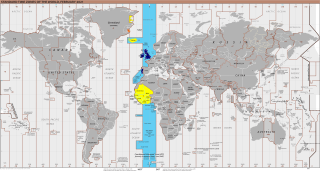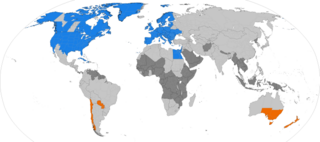Related Research Articles

A time zone is an area which observes a uniform standard time for legal, commercial and social purposes. Time zones tend to follow the boundaries between countries and their subdivisions instead of strictly following longitude, because it is convenient for areas in frequent communication to keep the same time.

Summer time in Europe is the variation of standard clock time that is applied in most European countries in the period between spring and autumn, during which clocks are advanced by one hour from the time observed in the rest of the year, with a view to making the most efficient use of seasonal daylight. It corresponds to the notion and practice of daylight saving time (DST) to be found in some other parts of the world.

Eastern European Time (EET) is one of the names of UTC+02:00 time zone, 2 hours ahead of Coordinated Universal Time. The zone uses daylight saving time, so that it uses UTC+03:00 during the summer.

Moscow Time is the time zone for the city of Moscow, Russia, and most of western Russia, including Saint Petersburg. It is the second-westernmost of the eleven time zones of Russia. It has been set to UTC+03:00 without DST since 26 October 2014; before that date it had been set to UTC+04:00 year-round on 27 March 2011.

Eastern European Summer Time (EEST) is one of the names of the UTC+03:00 time zone, which is 3 hours ahead of Coordinated Universal Time. It is used as a summer daylight saving time in some European and Middle Eastern countries, which makes it the same as Arabia Standard Time, East Africa Time, and Moscow Time. During the winter periods, Eastern European Time (UTC+02:00) is used.

UTC+02:00 is an identifier for a time offset from UTC of +02:00. In ISO 8601, the associated time would be written as 2020-11-08T23:41:45+02:00.

UTC+03:00 is an identifier for a time offset from UTC of +03:00. In areas using this time offset, the time is three hours later than the Coordinated Universal Time (UTC). Following the ISO 8601 standard, a time with this offset would be written as, for example, 2019-02-08T23:36:06+03:00.

Australia uses three main time zones: Australian Eastern Standard Time, Australian Central Standard Time and Australian Western Standard Time.

There are eleven time zones in Russia, which currently observe times ranging from UTC+02:00 to UTC+12:00. Daylight saving time (DST) has not been used in Russia since 26 October 2014. From 27 March 2011 to 26 October 2014, permanent DST was used.
Time in Chile is divided into three time zones. Most of Continental Chile uses the time offset UTC−04:00 in winter time and UTC−03:00 in summer time, while the Magallanes and Chilean Antarctica region uses the time offset UTC−03:00 the whole year. Additionally, Easter Island uses the time offset UTC−06:00 in winter time and UTC−05:00 in summer time.

Egypt Standard Time (EGY) is UTC+02:00, which is equivalent to Eastern European Time, Central Africa Time, South African Standard Time and Central European Summer Time, and is co-linear with neighbouring Libya and Sudan. Egypt has used Eastern European Summer Time (UTC+03:00), during the summer periods from 1957 to 2010, 2014, 2015, and 2023.

UTC+00:00 is an identifier for a time offset from UTC of +00:00. This time zone is the basis of Coordinated Universal Time (UTC) and all other time zones are based on it. In ISO 8601, an example of the associated time would be written as 2069-01-01T12:12:34+00:00. It is also known by the following geographical or historical names:

Europe spans seven primary time zones, excluding summer time offsets. Most European countries use summer time and harmonise their summer time adjustments; see Summer time in Europe for details.

Metropolitan France uses Central European Time as its standard time, and observes Central European Summer Time from the last Sunday in March to the last Sunday in October. With its overseas territories, France uses 12 different time zones, more than any other country in the world.
Daylight saving time in the Americas is the arrangement in the Americas by which clocks are advanced by one hour in spring and moved back in autumn, to make the most of seasonal daylight. The practice is widespread in North America, with most of Canada and the United States participating, but much less so in Central and South America.

As of 2022, daylight saving time is used in the following Asian countries:

African countries, apart from Egypt, do not use daylight saving time (DST) although some did in the past. Only the territories of the Canary Islands, Ceuta and Melilla (Spain) and Madeira (Portugal) implement DST from the last Sunday in March to the last Sunday in October. Although these regions politically belong to Europe, they are geographically part of Africa. They have DST schedules according to European Union rules.

Daylight saving time (DST), also known as summer time, is the practice of advancing clocks during part of the year, typically by one hour around spring and summer, so that daylight ends at a later time of the day. As of 2024, DST is observed in most of Europe, most of North America and parts of Africa and Asia around the Northern Hemisphere summer, and in parts of South America and Oceania around the Southern Hemisphere summer. It was also formerly observed in other areas.

In Turkey, time is given by UTC+03:00 year-round. This time is also called Turkey Time (TRT). The time at most is the same as in the Moscow Time and Arabia Standard Time zones. TRT was adopted by the Turkish Government on 8 September 2016. It was also in use in Northern Cyprus until it reverted to Eastern European Time (EET) in October 2017.

Time in Transnistria, a breakaway state internationally recognised as being part of Moldova, is given by Eastern European Time. Daylight saving time, which moves one hour ahead to UTC+03:00 is observed from the last Sunday in March to the last Sunday in October.
References
- ↑ Time zone in Nicosia, Cyprus. TimeAndDate.com.
- ↑ Occupied Northern Cyprus to Follow Turkey Time. TimeAndDate.com.
- ↑ Northern Cyprus Reintroduces DST. TimeAndDate.com.